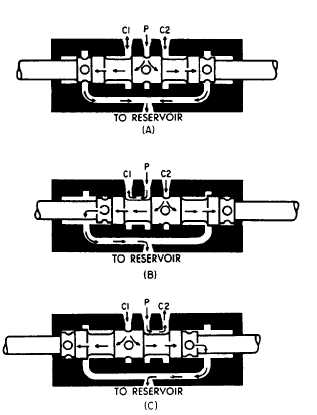return/exhaust (R), and two cylinder ports (C/1
and C2). A hollow sleeve fits into the main bore
of the body. There are O-rings placed at intervals
around the outside diameter of the sleeve. These
O-rings form a seal between the sleeve and the
body, creating chambers around the sleeve. Each
of the chambers is lined up with one of the fluid
ports in the body. The drilled passage in the body
accounts for a fifth chamber which results in
having the two outboard chambers connected to
the return/exhaust port. The sleeve has a pattern
of holes drilled through it to allow fluid to flow
from one port to another. A series of holes are
drilled into the hollow center sleeve in each
chamber.
The sleeve is prevented from turning by a
sleeve retainer bolt or pin which secures it to the
valve body.
The sliding spool fits into the hollow center
sleeve. This spool is similar to the spool in the
two-way valve, except that this spool has three
pistons or lands. These lands are lapped or
machine fitted to the inside of the sleeve.
One end of the sliding spool is connected to
a handle either directly or by mechanical linkage
to a more desirable location. When the control
handle is moved, it will position the spool within
the sleeve. The lands of the spool then line up
different combinations of fluid ports thus
directing a flow of fluid through the valve.
The detent spring is a clothespin-type spring,
secured to the end of the body by a spring
retaining bolt. The two legs of the spring extend
down through slots in the sleeve and fit into the
detents. The spool is gripped between the two legs
of the spring. To move the spool, enough force
must be applied to spread the two spring legs and
allow them to snap back into the next detent,
which would be for another position.
Figure 6-34, view A, shows a manually
operated sliding spool valve in the neutral
position. The detent spring is in the center detent
of the sliding spool. The center land is lined up
with the pressure port (P) preventing fluid from
flowing into the valve through this port. The
return/exhaust port is also blocked, preventing
flow through that port. With both the pressure
and return ports blocked, fluid in the actuating
lines is trapped. For this reason, a relief valve is
usually installed in each actuating line when this
type of valve is used.
Figure 6-34, view B, shows the valve in the
working position with the end of the sliding spool
retracted. The detent spring is in the outboard
detent, locking the sliding spool in this position.
The lands have shifted inside the sleeve, and the
ports are opened. Fluid under pressure enters the
sleeve, passes through it by way of the drilled
holes, and leaves through cylinder port C2. Return
fluid, flowing from the actuator enters port C1,
flows through the sleeve, and is directed out the
return port back to the reservoir or exhausted to
the atmosphere. Fluid cannot flow past the spool
lands because of the lapped surfaces.
Figure 6-34, view C, shows the valve in the
opposite working position with the sliding spool
extended. The detent spring is in the inboard
detent. The center land of the sliding spool is now
on the other side of the pressure port, and the
fluid under pressure is directed through the sleeve
and out port C1. Return fluid flowing in the other
cylinder port is directed to the drilled passage in
the body. It flows along this passage to the other
end of the sleeve where it is directed out of the
return/exhaust port.
The directional control valves previously
discussed are for use in closed-center fluid power
systems. Figure 6-35 shows the operation of
Figure 6-35.—Open center, sliding spool directional control
valve.
6-24


